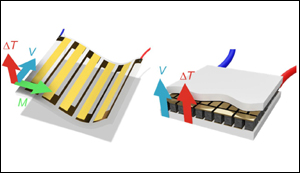Abundant element to power small devices
27. 4. 2020 | University of Tokyo | www.u-tokyo.ac.jp/en/index.html
Researchers have found a way to convert heat energy into electricity with a nontoxic material. The material is mostly iron which is extremely cheap given its relative abundance. A generator based on this material could power small devices such as remote sensors or wearable devices. The material can be thin so it could be shaped into various forms.
"So far, all the study on thermoelectric generation has focused on the established but limited Seebeck effect,” said Nakatsuji. “In contrast, we focused on a relatively less familiar phenomenon called the anomalous Nernst effect (ANE).” ANE produces a voltage perpendicular to the direction of a temperature gradient across the surface of a suitable material. The phenomenon could help simplify the design of thermoelectric generators and enhance their conversion efficiency if the right materials become more readily available.

“We made a material that is 75 percent iron and 25 percent aluminum (Fe3Al) or gallium (Fe3Ga) by a process called doping,” said Sakai. “This significantly boosted ANE. We saw a twentyfold jump in voltage compared to undoped samples, which was exciting to see.”
Read more at University of Tokyo
Image Credit: University of Tokyo
-jk-




